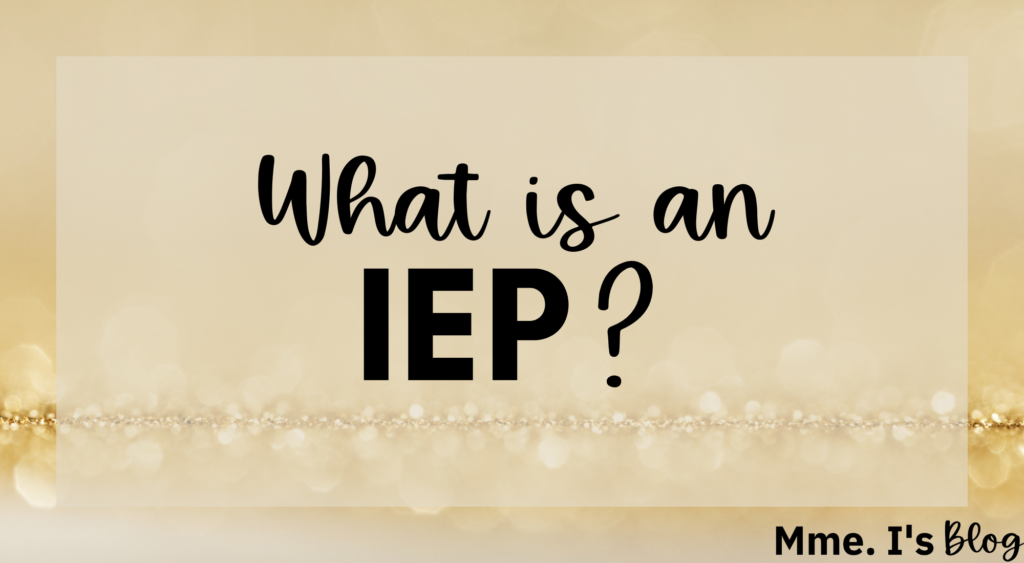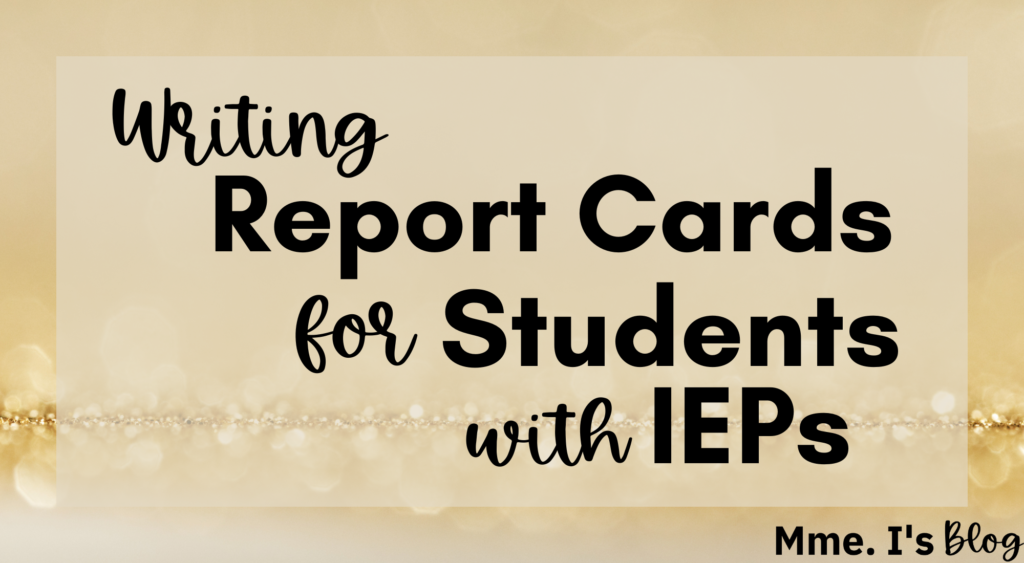
An important part of our job as teachers is to write Individual Education Plans (IEPs) for students. IEPs are an important tool in helping students reach their educational goals and ensure that their learning needs are met.
Yet, I was never taught how to write an IEP. Were you?
Writing an IEP requires thoughtful consideration and preparation. It requires an understanding of the learning goals, the curriculum expectations, and an understanding of the student’s individual needs and learning capabilities. While certain parts of the IEP are developed by a team of professionals, which will often include the student’s parents, there is always a page for Core French teachers which we are expected to write ourselves (at least that is how it is in my School Board).
Here are the IEP basics you need to know.

Before we begin talking about how to write an IEP, it’s important to understand what an IEP is.
An IEP, or Individual Education Plan, is a written plan developed by a team including a student’s parents and teachers. This team is typically called an Identification, Placement and Review Committee (IPRC), though they may have a different name in your school board. The IEP outlines the type of educational support and accommodations that a student requires to succeed in school. It is designed to meet the individual needs of a student and is generally used in Ontario school boards as a way to provide extra help to students with special learning needs in order to ensure that their needs are being met.
An IEP must be developed for each child who requires one, within 30 days of the start of the term. This means that an IEP is created both at the beginning of a new school year as well as at the beginning of a new term. Once created, an IEP is stored in the Ontario Student Record (OSR).
It is important to remember that an IEP is a legal document. Whatever we put into this document becomes binding upon us as teachers. That is why the IEP writing process requires our time, due diligence and commitment. That being said, the IEP is a working document and when we see the need to make changes to support the student in their learning, we may do so.

While an IEP has many parts and many pages, as the Core French teacher, you will only be responsible for your page. The Ministry of Education provides their expectations for what an IEP must contain as well as a sample IEP template. Check out this document. Each school board, however, has the option to create their own version. As a result, your expectations for completing an IEP may be a little different from those of mine, but the basics will remain the same as they are Ministry guidelines.
That being said, here are the important steps I take when writing an IEP for Core French:
- Identify the Basics
- Develop an Annual Program Goal
- Consider Learning Expectations, Teaching Strategies and Assessment Methods
Let’s delve into each of these sections below.
IDENTIFY THE BASICS
At the top of your specific IEP page, there is some basic information about the student and the subject. For me, this information is usually inputted by the Spec Ed teacher.
This section includes the name of the subject for which the curriculum is being modified as well as the student’s previous level (on the achievement chart) and grade in this subject.
One other thing to note is whether you will be providing accommodations, modifying the curriculum or providing an alternative curriculum. Once again, your Special Education teacher will likely tell you which of these applies, as it is not a decision you make yourself.
DEVELOP AN ANNUAL PROGRAM GOAL
This is the first important piece of information you have to enter into the IEP. What do you expect the student to accomplish by the end of the school year?
Your Annual Program Goal should consider your student’s strengths, needs and current level of achievement. It should be realistic and observable.
Here is what a general Annual Program Goal typically looks like for Core French: By the end of the school year, Student will communicate an understanding of some of the basic concepts covered in each strand of the Grade # French Curriculum.
Depending on the student, this Annual Program Goal can and should be modified. For example, based on the student’s needs, you may not want to assess each strand of the Curriculum. Perhaps you’ll only assess 2 of 4 strands. You will need to make that decision on a case-by-case basis.
CONSIDER LEARNING EXPECTATIONS, TEACHING STRATEGIES AND ASSESSMENT METHODS
Apart from the Annual Program Goal, this is the only other main section of the IEP for which you are responsible.
LEARNING EXPECTATIONS
Learning Expectations refer to specific curriculum expectations. Before you can complete this section, you must think about the strands you will be assessing. Is this particular student going to be assessed on each of the four strands? Or, maybe you’ll assess two this term and two next term? Hopefully you’ve already decided this before you wrote your Annual Program Goal and this part will be easy.
Now, it’s time to think specifically. How many specific expectations in your strands of choice would you like to assess? Below each strand list these expectations in the IEP.
While some students may be able to accomplish the specific expectation you have chosen, for students who are receiving modifications, you will typically modify the expectation by reducing it in complexity. Take a look at the example I will share below and hopefully this will make more sense.
As a general rule, seeing as this is a legal document, I always believe that fewer is better. Set one or two specific expectations. Once you get to know the student, reassess your expectations and modify the IEP. This could include reducing expectations, adding more expectations, or altering an expectation altogether.
While many of the students for whom you are writing an IEP will be on the same grade level as that which you are teaching, you will occasionally come across students who are working below grade level, and you must select specific expectations from a lower grade. Consequently, you must make sure you include the grade level at the end of each expectation so that there is no confusion.
Here is an example of a specific expectation taken directly from the Ontario Core French, Grade 6, Listening Curriculum:
demonstrate an understanding of the purpose and meaning of oral French texts containing familiar and new words and expressions about themselves, family, friends, and topics of personal interest, with contextual and visual support
Here is an example of this specific expectation being modified for an IEP:
Student will demonstrate an understanding of the meaning of oral French texts containing familiar words and expressions about themselves, family, friends, and topics of personal interest, with context and visual support (6).
TEACHING STRATEGIES
The next section asks you to consider teaching strategies you will use to help your student meet their learning expectations.
For this section, think about your teaching style and method and how you plan to support this student in achieving their specific goals. List however many strategies you intend on using. Then, remember to actually use them in your day-to-day teaching!
These strategies may include things like:
- Providing visual aids
- Reviewing vocabulary and definitions
- Providing students with checklists
- Using assistive technology to support the student’s learning
- Breaking tasks into small chunks
ASSESSMENT METHODS
The last section has you consider what assessment methods you will use to assess student competency and understanding to determine whether a student has met their IEP goals. This section will often look different for each child, based on their strengths and needs.
- Will you use check-bricks?
- Will your assessment be based on conversations?
- Perhaps you are having the student present something? Write something?
- Maybe this looks like allowing for extra time to complete a task?

Now that the term has begun and you are done writing your IEP, you are going to ensure that you work towards implementing it in your daily teaching practice. Taking the time to make considerations for students on IEPs is key. When the time for report cards rolls around, you will be reporting on these students based on their IEPs. Here’s how:
Writing Report cards for students with IEPs is actually quite simple. The Report Cards must reflect the expectations set out in the IEP.
For this, I simply take the specific expectations and copy them into the comment box on the report card for Core French and identify whether or not the student has met that goal.
Using the specific expectation mentioned above, here is how I would report on a student’s progress:
Student will demonstrate an understanding of the meaning of oral French texts containing familiar words and expressions about themselves, family, friends, and topics of personal interest, with context and visual support (6).
Term 1 IEPs go home to parents early in the year (late September, early October) while Term 2 IEPs go home with Term 1 Report Cards.

- Keep a list of IEP students handy. This could be on a specific page in your planner or on a sticky note in your office. It doesn’t need to be fancy. It just needs to be easily accessible and something you are reminded of often (if not daily), to ensure that you are meeting these students’ needs.
- If you’re not assessing all four strands each term, try to assess the same strand for each IEP student, each term. This means, I may choose to assess Listening, Speaking and Writing in Term 1, for all of my IEP students. For Term 2, I may choose to assess Listening, Speaking and Reading, for each IEP student. Of course, this may not work based on your students’ needs and you will have to modify this accordingly, but wherever possible, it will make your life easier if you do.
- Keep a record of the information you submit in the IEP (include everything from Annual Learning Goal to strands and specific expectations chosen). While this can be printed and saved in a folder at your desk, I typically like to insert this information into a Google Doc and save it in my Google Drive. It makes it easier to access again in future years, and possibly reuse some of the expectations for that specific grade (based on student needs, of course!).
- Set dates and times for yourself, throughout the term, to refer back to your IEP expectations and assess whether or not they are being met or need to be modified. At the end of the term, when it comes time to write report cards, you want to be certain you accomplished what you had set out to accomplish with your students. Remember to spend some time to consider whether or not you are using those teaching strategies and assessments methods which you had indicated in the IEP.

